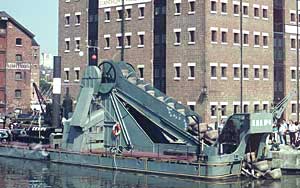First Steam-powered Dredger
The first steam-powered bucket dredger
on the canal was built in 1849, when the accumulated silt had reduced
the depth of water from 18ft to only 14ft, and large ships had to
have some of their cargo discharged at Sharpness before navigating
the canal. This dredger had a wooden hull built by local shipbuilder
William Hunt, and the dredging machinery was supplied by Rothwell
& Co. of Bolton. In the first two years of operation, over 150,000
tons of mud were removed, and the canal was almost back to its full
depth again.
Two More Dredgers
This
original dredger was quite adequate for the routine work of maintaining
a depth of 18ft in the canal, but the construction of the new dock
at Sharpness with a maximum depth of 24ft highlighted the need for
a dredger with a greater capability. So in 1874 the Dock Company
purchased a suitable dredger from the Witham Drainage Commissioners,
and it was immediately put to work to clear the bank that had been
left between the new dock and the existing canal. By this time,
the Dock Company had also taken over responsibility for the Worcester
& Birmingham Canal, and in 1875 they purchased a small dredger
for that canal from Fielding & Platt of Gloucester. With three
steam dredgers owned by the Company, it made sense to give them
numbers: the original dredger became No 1, the Worcester dredger
No 2 and the Witham dredger No 3.
Replacement Dredgers
By
the 1890s, the Company's dredgers were in a poor condition. In particular
the wooden hull of No 1 was rotten, and so the boiler, engine and
buckets were transferred to a new iron hull with gantry and bucket
ladder built by Fielding & Platt of Gloucester. The old Witham
dredger was also in a bad way, and as there was a need for a lot
of dredging at Sharpness in connection with the construction of
a new quay wall, another dredger capable of dredging to 28ft was
purchased from the Bristol Docks Committee in November 1896. Confusingly,
these two "new" dredgers were not given new numbers. The
Fielding & Platt dredger became the second No 1, and the Bristol
dredger became the second No 3. To add to the confusion, the label
No 2 was transferred to a steam-powered scraper dredger, built by
Fielding & Platt, that was used to scrape mud to the centre
of the Sharpness tidal basin where it could be sluiced away.
No 4 Dredger
The Company
operated these three dredgers, as needed, throughout the early years
of the twentieth century, but as they got older they needed more
frequent repairs, which interrupted the progress of the dredging
operations. After much deliberation, therefore, a new dredger was
purchased in 1925 from the Dutch firm de Klopp, and this time logic
prevailed as it was given the next number in the series - No 4.
The Fielding & Platt dredger was hired to the Severn Commission
and later transferred by British Waterways to the River Weaver.
The Bristol dredger had all its machinery removed and the hull was
converted to a pontoon called Encore, which now supports the office
at Sharpness Marina. No 4 dredger continued operating on the canal
until it was replaced in 1981 by a diesel-electric dredger named
Thomas Fletcher after the resident engineer who supervised the final
phase of the construction of the canal in the 1820s.
Main sources: PRO RAIL 864 Dock Co. minute books. |
